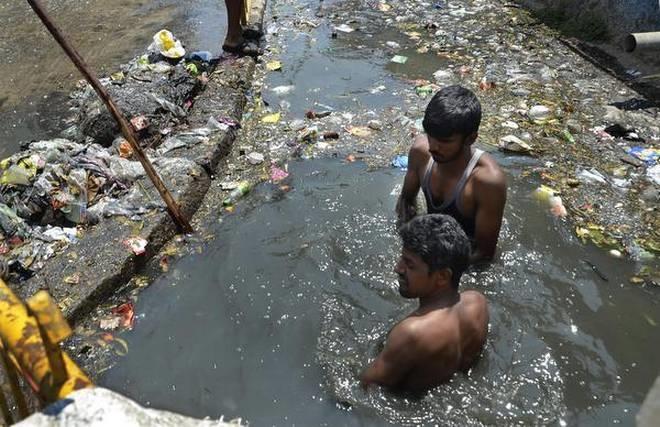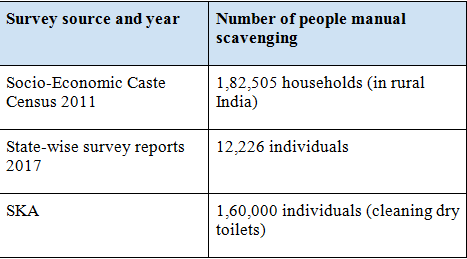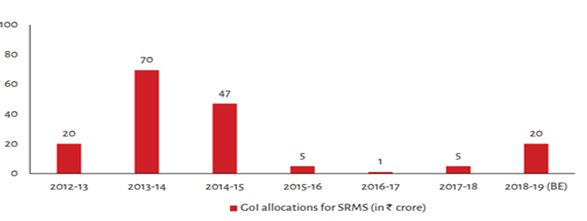Another Cheat Survey, in the Name of Manual Scavengers

Image Coutesy: The Hindu
Many of us wonder why in today’s age manual scavenging is still a practice, and why sanitation workers are still dying on duty. A report claims that over 300 manual scavengers died in 2017, which means we lost one sanitation worker on almost every day of 2017. The recent “survey” initiated by our government offers an opportunity to understand why we still fail at stopping manual scavenging. And if this is how our government keeps functioning, unfortunately but unsurprisingly, we will continue to see more deaths in future.
The Government of India is conducting a survey to identify manual scavengers in the country these days. It was announced last year because of the increasing number of sanitation workers’ death while doing manual scavenging. It was realised that the deaths of these manual scavengers were not on the government list. As a result, the Ministry of Social Justice and Empowerment decided to survey manual scavengers in several phases to ensure the proper implementation of the Prohibition of Employment as Manual Scavengers and their Rehabilitation Act, 2013. The Ministry chose to first survey only those manual scavengers who clean dry latrines and pit latrines. Others will be surveyed in the second phase.

A mere game of numbers: Failure of multiple surveys of manual scavengers to identify the exact number of people engaged in the practice.
The responsibility of conducting the survey is given to National Safai Karamcharis Finance and Development Corporation (NSKFDC), a central government agency under the Ministry of Social Justice and Empowerment. NSKFDC is also responsible for the implementation of Self-Employment for Rehabilitation of Manual Scavengers (SRMS) scheme. The SRMS scheme remains inefficient at stopping manual scavenging and its funds remain underutilised. NSKFDC depends on nodal offices of different state governments to execute SRMS. For this survey as well, NSKFDC depends on the same nodal offices. The nodal offices, which have repeatedly failed to identify manual scavengers, avail SRMS and rehabilitate them, are now again entrusted again with the task of surveying them. It is not surprising at all that they conducted this survey with the same inefficiency and lack of interest.
Maharashtra government is one of the states that have not yet submitted their status report to the Centre on implementation of the 2013 Act banning manual scavenging. The lack of interest of the Maharashtra government in stopping manual scavenging is very visible, its inactions speaking loud. While many state governments, as mandated by the Supreme Court, have paid the compensation of Rs. 10 lakh to the families of those who died in manholes, Maharashtra government remains deaf to the pleas of the victims’ families. With the same shamelessness, not a single nodal officer from the Maharashtra government attended the workshop held by NSKFDC in Delhi for this survey, while the nodal officers from almost all other states in the country were present. The nodal officers in Maharashtra did not even have the details of the survey camps when contacted as the surveys were going on.
The reports from all the 14 districts where camps were held in Maharashtra in April are disappointing. These districts include Akola, Amravati, Aurangabad, Buldana, Dhule, Jalgaon, Jalna, Latur, Mumbai, Nagpur, Nandurbar, Nashik, Solapur, and Washim. There was hardly any time or money spent on advertising the survey at any of these locations. The Maharashtra government didn’t even reveal the camp locations and dates to media, which could gain them free publicity. The details mentioned on the NSKFDC website did not match the actual camp dates and locations. At many of the camp locations, sanitation workers were unaware of it. Also, the survey was conducted in a hurry. All the camps were held for one day at each location. Before the people could know about the survey and camp locations through the word of mouth, the survey ended. Some of the planned camps were cancelled without any notice or explanations. The government officers made many violations of the survey protocol rendering the outcome of this survey unreliable and useless.
In Mumbai Metropolitan Region, all the camps for the survey were held in South Mumbai, the most developed area of the city. The government expects to find dry and pit latrines and those who clean them in this region, where property rates are among the highest in India. The survey was not held in the outskirts of the city where sewer lines are not yet built and manual scavenging of dry latrines is more likely. In addition, only those sanitation workers were allowed to fill the survey forms who live in the areas where camps were held. Even those sanitation workers who clean South Mumbai are not able to afford housing here. They mostly come from suburbs and the outskirts of the city and travel on a daily basis. Also, the most marginalised sanitation workers who live in the outskirts of Mumbai, who are most likely to do manual scavenging, are very easily excluded from the benefits of this survey because of its geographical limitations.
Most importantly, the way those sanitation workers who approached the camps were denied an entry into the list is highly questionable. The workers were asked to get their forms stamped by their employers, declaring that they are employed as manual scavengers. No employer who illegally makes a sanitation worker do manual scavenging is going to attest to that. Also, the workers were asked to furnish their employee ID. The nodal officers in Maharashtra are completely and foolishly ignorant about the informal nature of manual scavenging. The way they execute SRMS scheme should also be critically and thoroughly investigated. Most of the sanitation workers who could manage to reach the camps were turned away and those who qualified were asked to fill the form later and submit later at the designated offices.
It is also quite obvious by now that no social scientist or professional researcher has been involved in the designing of this poorly and unprofessionally conducted survey. No trained surveyor would approve of a survey being conducted in such a hurry. There should have been at least two months of publicity period before the survey camps were held. The publicity and communication budget were obviously missing from their plan. There were also no efforts from the government officials to reach the locations where manual scavengers live or work. Instead, the manual scavengers were expected to look for the camp locations. No survey can succeed with such a laid-back approach. This survey design would even fail an assignment test if submitted at the Bachelor level to a social science teacher.
Ending manual scavenging is not even mentioned as one of the objectives of the Swachh Bharat Mission (SBM). SBM is spending a lot of money on building new toilets and is running a campaign to shame those who still openly defecate. No amount is being spent on improving the public awareness about the dangerous implications of manual scavenging. The graph shows how the Union budget allocation for rehabilitation of manual scavengers has come down over the years. In addition, the allocated budget isn’t even spent properly. No amount was spent on rehabilitation of manual scavengers between 2014 and 2017. It is only within the last one year that the government has spent Rs. 56 crore on the rehabilitation of manual scavengers. It is more important to make India look clean, to put people behind walls while they defecate, but it is not at all important to make sure that nobody dies in their feces. As Bezwada Wilson contends, there can be no Swachh Bharat without ending manual scavenging that is rooted in the caste structure.

A sharp drop in the government investment to stop manual scavenging in past few years (Source: Centre for Policy Research Budget Briefs 2018, Vol 10, Issue 5)
Ashif Shaikh, an anti-manual scavenging activist and founder of Jan Sahas in Madhya Pradesh, argues that acknowledging the existence of manual scavenging is the first step towards ending it. However, this survey seems like another deliberate attempt on behalf of the Maharashtra government to not get manual scavengers identified. The fewer the manual scavengers they “find”, the taller their claim to have eradicated manual scavenging, the better their success story of Swachh Bharat Mission. Also, it gives the Centre legitimacy to further cut down the budget for rehabilitation of manual scavengers. In other words, this survey and the way it is conducted gives another opportunity to the government to cheat manual scavengers.
Get the latest reports & analysis with people's perspective on Protests, movements & deep analytical videos, discussions of the current affairs in your Telegram app. Subscribe to NewsClick's Telegram channel & get Real-Time updates on stories, as they get published on our website.
























